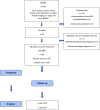The impact of Human Papilloma Virus status on the prediction of head and neck cancer chemoradiotherapy outcomes using the pre-treatment apparent diffusion coefficient
- PMID: 34111977
- PMCID: PMC8822554
- DOI: 10.1259/bjr.20210333
The impact of Human Papilloma Virus status on the prediction of head and neck cancer chemoradiotherapy outcomes using the pre-treatment apparent diffusion coefficient
Abstract
Objective: To determine the impact of Human Papilloma Virus (HPV) oropharyngeal cancer (OPC) status on the prediction of head and neck squamous cell cancer (HNSCC) chemoradiotherapy (CRT) outcomes with pre-treatment quantitative diffusion-weighted magnetic resonance imaging (DW-MRI).
Methods: Following ethical approval, 65 participants (53 male, age 59.9 ± 7.86) underwent pre-treatment DW-MRI in this prospective cohort observational study. There were 46 HPV OPC and 19 other HNSCC cases with Stage III/IV HNSCC. Regions of interest (ROIs) (volume, largest area, core) at the primary tumour (n = 57) and largest pathological node (n = 59) were placed to analyse ADCmean and ADCmin. Unpaired t-test or Mann-Whitney test evaluated the impact of HPV OPC status and clinical parameters on their prediction of post-CRT 2 year locoregional and disease-free survival (LRFS and DFS). Multivariate logistic regression compared significant variables with 2 year outcomes.
Results: On univariate analysis of all participants, the primary tumour area ADCmean was predictive of 2 year LRFS (p = 0.04). However, only the HPV OPC diagnosis (LFRS p = 0.03; DFS p = 0.02) predicted outcomes on multivariate analysis. None of the pre-treatment ADC values were predictive of 2 year DFS in the HPV OPC subgroup (p = 0.21-0.68). Amongst participants without 2 year disease-free survival, HPV-OPC was found to have much lower primary tumour ADCmean values than other HNSCC.
Conclusion: Knowledge of HPV OPC status is required in order to determine the impact of the pre-treatment ADC values on post-CRT outcomes in HNSCC.
Advances in knowledge: Pre-treatment ADCmean and ADCmin values acquired using different ROI methods are not predictive of 2 year survival outcomes in HPV OPC.
Conflict of interest statement
Figures




References
-
- Berrak S, Chawla S, Kim S, Quon H, Sherman E, Loevner LA, et al. . Diffusion Weighted Imaging in Predicting Progression Free Survival in Patients with Squamous Cell Carcinomas of the Head and Neck Treated with Induction Chemotherapy. Acad Radiol 2011; 18: 1225–32. doi: 10.1016/j.acra.2011.06.009 - DOI - PMC - PubMed
-
- Chawla S, Kim S, Dougherty L, Wang S, Loevner LA, Quon H, et al. . Pretreatment diffusion-weighted and dynamic contrast-enhanced MRI for prediction of local treatment response in squamous cell carcinomas of the head and neck. AJR Am J Roentgenol 2013; 200: 35–43. doi: 10.2214/AJR.12.9432 - DOI - PMC - PubMed
Publication types
MeSH terms
Substances
LinkOut - more resources
Full Text Sources
Medical
Research Materials

